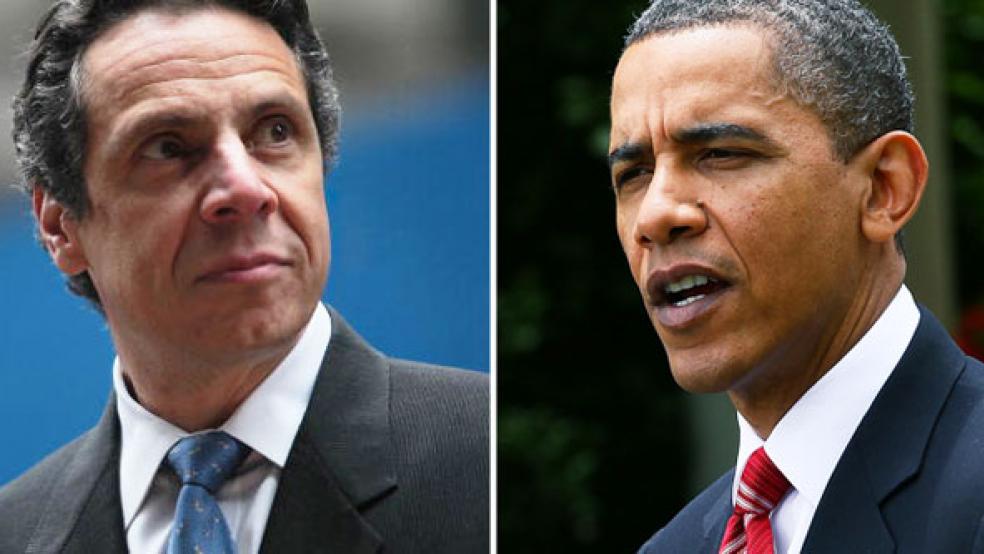If they can make an “on time” budget here, they can make one anywhere, even in Washington. New York State has a long and undistinguished history of late budgets. But on Sunday, Gov. Cuomo and the legislative leaders announced that they had reached agreement on a $132.5 billion budget for fiscal 2012 — five days early. Some details still need to be hammered out, but the lawmakers expect the completed budget to be voted on or before the April 1 deadline.
Why was Andrew Cuomo, in his first year in office as governor of New York, able to deliver a tough 2012 budget agreement before the deadline, while President Obama and Congress are still clashing over the 2011 federal budget, with the prospect of a government shutdown looming if the two sides don’t reach a deal by April 8?
The answer, in large part, lies in the power dynamics built into the New York budget system and that of the federal government. Under New York’s constitution, the governor is required to submit a budget and the appropriations bills implementing that fiscal plan. “It’s a very strong executive system,” says Frank Mauro of the left-leaning Fiscal Policy Institute. “It doesn’t leave the legislature much bargaining power.”
The balance of budget-making power is much different in Washington. Under the federal system of checks and balances, the president submits a budget proposal, but all bills must originate in the House of Representatives and Congress handles the appropriations, meaning that lawmakers have much more sway over the spending specifics. “The president has to rely more on his political influence and the bully pulpit and whatever other powers he has available,” says Mauro.
The circumstances in New York, of course, are similar to those in so many states struggling with steep deficits and depressed tax revenues. Across the country, 44 states and the District of Columbia are projecting budget shortfalls totaling $112 billion for fiscal 2012, according to a recent report by the Center on Budget and Policy Priorities. And in some ways, the situation in New York is similar to the one facing the federal government, too, though the federal government is able to run a deficit while states are legally obligated to balance their budgets each year.
New York last adopted a budget on time five years ago and since 1984, only three budgets have been completed by the April deadline. The fiscal 2011 spending plan, by contrast, was passed in August 2010, 125 days late. The last time the state had a budget done early was 1983, under newly elected Gov. Mario Cuomo, the current governor’s father.
“It is a big deal when this state passes a budget on time,” said Andrew Cuomo at a press conference announcing the agreement. “It's an exceptionally big deal when the state passes the budget on time under these circumstances.”
Cuomo forcefully wielded his constitutional authority. He charmed and politicked his way to a deal — but he also threatened to use an innovative gambit devised last year by New York’s outgoing Gov. David Paterson. Locked in a protracted showdown with the state legislature, Paterson put his spending plan into the emergency extension bills used to keep the government running, and forced legislators to make a choice: Either work with his plan or shut down the state government.
Governor Cuomo threatened to use the same tactic if a budget deal wasn’t reached in time. “Even if the legislature causes a shutdown of government, it will only be temporary and it will only delay, not derail, our budget's final passage, ” he said last week in a video posted to his official website. The threat helped get legislators to the bargaining table and helped Cuomo get his budget through largely intact.
Cuomo also employed a novel approach to some cuts, proposing target values but delegating the specific, and potentially contentious, decisions about how to reach those targets to special task forces. The governor called for deep cuts to Medicaid spending, for example, but appointed a committee of experts to work through the details. “It was a process of bringing stakeholders together to have them work through differences,” says Morris Peters, a spokesman for the state Division of Budget. While previous governors who proposed Medicaid cuts found themselves the target of critical television ads, Cuomo avoided any such public condemnation. “This year you had those same people running ads in the paper asking the legislature to sign on to the agreement,” Peters says. “That’s what happens if you bring people together and have them work in cooperation.”
That task force model holds promise, even at the federal level, says Carol Kellermann, president of the Citizens Budget Commission, a fiscally conservative group focused on New York finances. But the problems President Obama and Congress must contend with are much thornier — particularly when it comes to entitlement programs. The president last year tried a similar committee approach when he appointed the bipartisan National Commission on Fiscal Responsibility and Reform. The commission’s recommendations, released in December, haven’t gotten much traction.
Kellermann says the difference between the processes boiled down to political courage and resolve. “We have to do less with less,” she says. New York’s politicians ultimately accepted that. “Some acknowledgement of that is probably needed on the federal level.”
Related Links:
A Budget for New York (Buffalo News):
Cuomo’s Lesson for Christie (Newark Star Ledger):
NY Judiciary Faces Another $70M Budget Cut (WSJ):



